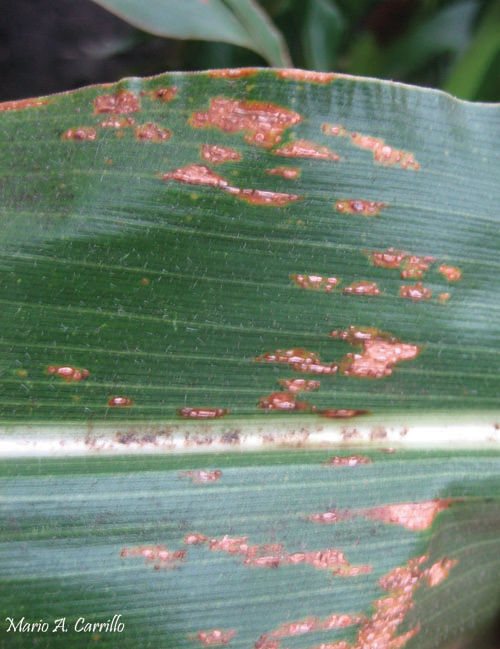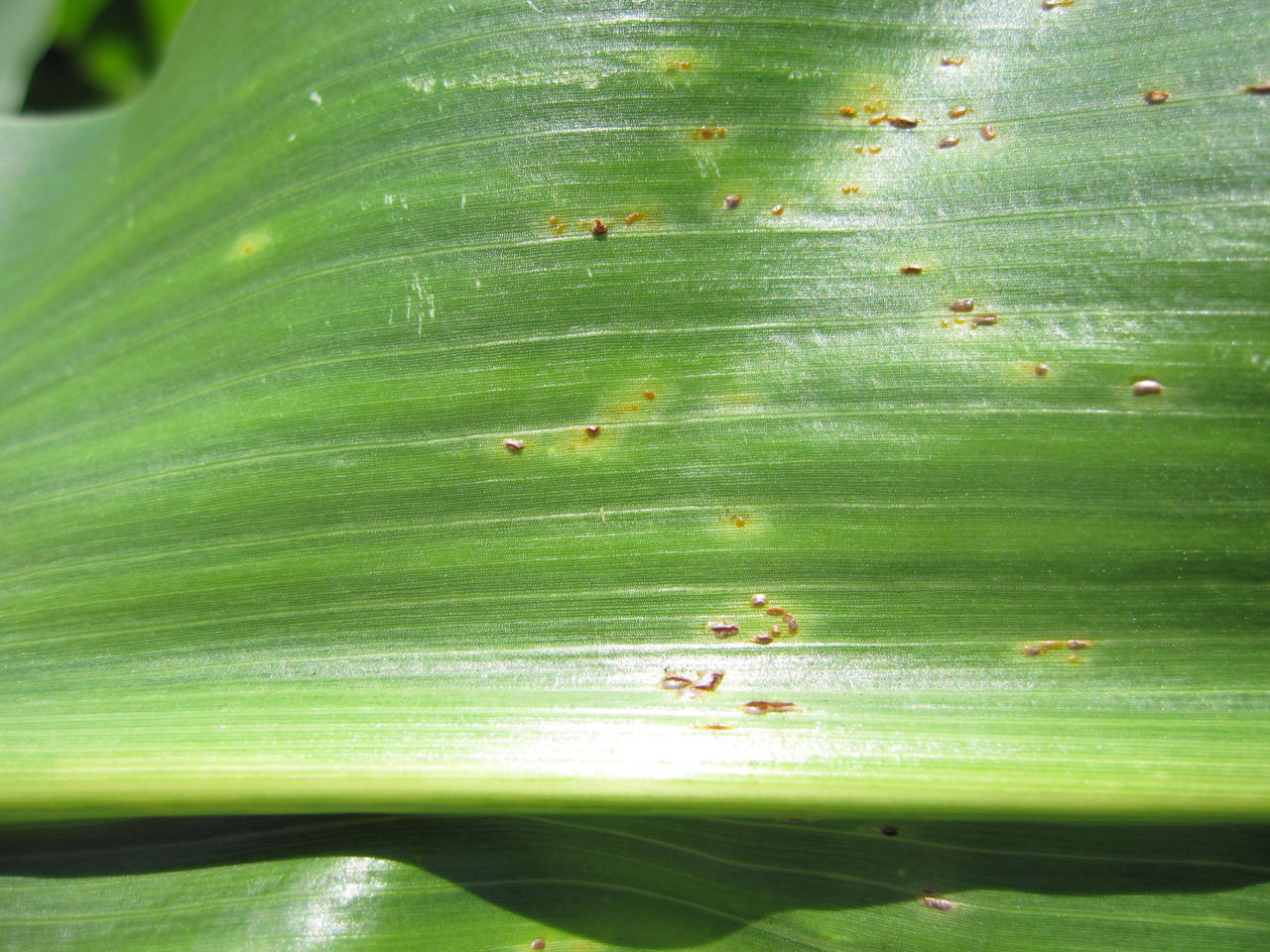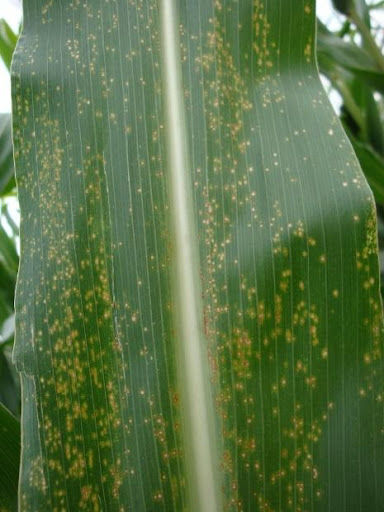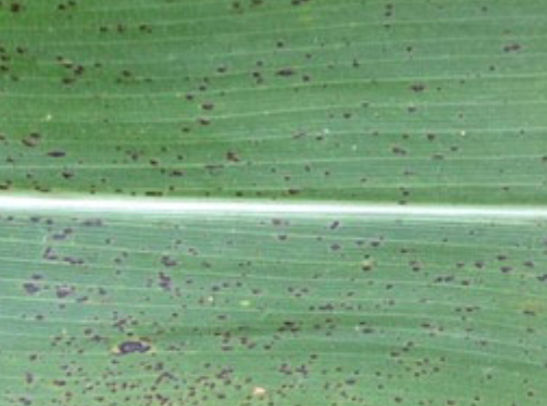4 MIN READ
Common Corn Rust
November 1, 2023
- Common rust is a disease that occurs in temperate to subtropical areas, including the Midwest. Though it cannot overwinter in the Midwest, windborne spores reach northern areas of the US and Canada from southern areas where overwintering is possible.
- Common rust is rarely an economic problem and can usually be managed by planting tolerant corn products, although a fungicide application may be warranted from time to time.
Disease cycle
Common rust occurs frequently in the Corn Belt. It is a fungal disease that is found in temperate to subtropical areas, including the Midwest. Though it cannot overwinter in the Midwest, windborne spores reach northern areas of the US and Canada from southern areas where overwintering is possible. Common rust development is favored by temperatures ranging from 60 to 77 °F (15 to 25 °C) and moist conditions caused by rain, dew, or 95% or greater relative humidity. Spores that land on leaf tissue can germinate in 3 to 6 hours if continuous moisture is present.
The disease is common on younger leaves that form a whorl, as water will pool in the whorl long enough for spores to germinate. Infections that do take place in a leaf whorl often result in pustules forming along bands. The early symptom of common rust is the appearance of chlorotic flecks on the upper and lower leaf surface that develop into powdery, oval or elongated, red pustules about 1/8 inch long (3 mm) as the spores break through the leaf surface. Pustules are scattered sparsely or clustered (Figures 1 and 2) and the spores they contain can be brushed off the leaf. The leaf tissue around the pustules may become chlorotic and may die, resulting in a lesion of dead tissue. The lesions sometimes form a band across the leaf, and entire leaves will die if severely infected. As the pustules age, the red spores turn black, making the pustules appear black, and continue to erupt through the leaf surface. Corn husks, leaf sheaths, and stalks may also become infected.1


Impact
If infection occurs late in the season, the potential for economic yield loss is minor. However, the potential for economic yield loss increases if spores arrive early in the season, infection occurs when the plants are small, and the environment remains favorable for rust development. Corn products differ in their level of resistance to common rust; therefore, the disease development rate can be different for each product that is grown. Late-planted corn may have higher levels of infection because the growth of new leaves coincided with spore arrival from overwintering locations. Severely infected plants may show water stress during hot, dry weather, because the pustules allow water to escape from the plant.2
Management
Planting corn products with higher levels of common rust tolerance is the best management option. General plant tolerance reduces the number and size of pustules and reduces overall severity of infection. Fungicides can effectively control common rust if initial applications are made while there are only a few pustules present per leaf. Though fungicides are commonly used in sweet corn and seed corn production, they are rarely warranted in field corn for common rust because the potential for economic damage is low. Scouting each corn field on a regular schedule can help determine if fungicide applications should be considered. If significant levels of common rust are present on the lower leaves prior to silking and the forecast is for cool and humid or wet conditions, a fungicide application may be beneficial.
Common Rust vs Other Similar Diseases
Southern corn rust
Another rust disease, southern corn rust can be confused with common rust. The distinguishing characteristic for southern rust is that the pustules form mostly on the upper leaf surface and are densely clustered, whereas common rust pustules form on both leaf surfaces and are sparsely clustered. In addition, southern rust spores are more orange in color (Figure 3). Southern rust spreads much more quickly and has a higher economic impact when hot, humid weather conditions persist that favor its development. Timely fungicide applications to control southern rust are more crucial than with common rust.3
Physoderma brown spot
This fungal disease produces small, round, yellow-brown lesions that often occur in bands across the leaf (Figure 4). Dark purple to black circular lesions also occur on the midrib of the leaf. Unlike common rust, Physoderma brown spot leaf lesions do not have spores that can be brushed off the leaf. Common rust also lacks the purple to black lesions on the midrib of Physoderma brown spot.

Eyespot
This fungal disease causes lesions that are tiny (1/8 to 1/4 inch, 3 to 6mm), clustered, circular spots with tan or brown centers (Figure 5). Each lesion forms a translucent yellow halo around the margin, which can be easily observed if the leaf is held up to the sun. Lesions may join, causing a large portion of the leaf to die. The fungus that causes eyespot does not produce the raised, red pustules that develop on the leaf surfaces of plants infected with common rust.

Tar spot
Tar spot produces small, raised, round, shiny black fungal structures that can be surrounded by narrow tan halos (Figure 6). These raised structures (stromata) feel bumpy to the touch. Leaves may have a few stromata, or they may densely cover the leaf. Tar spot stromata cannot be rubbed off the plant like common rust fungus spores can. Since tar spot stromata could be confused with the dark, older pustules of common rust, a laboratory may need to confirm which disease is present.

Sources
1 2019. Common rust of corn 2019. Crop Protection Network. https://cropprotectionnetwork.org/encyclopedia/common-rust-of-corn
2 Shaner, G. 2000. Corn rust - An epidemic? Purdue University. Corny News Network. https://www.agry.purdue.edu/ext/corn/news/articles.00/Corn_Rust-0713.html
3 Bradley, C. et al. 2017. Southern rust. Crop Protection Network. https://crop-protection-network.s3.amazonaws.com/publications/cpn-2009-southern-rust.pdf
1211_61211